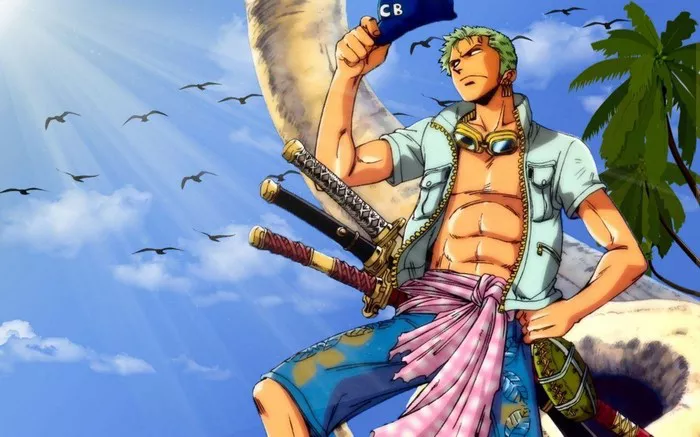Roronoa Zoro, the legendary swordsman from the popular manga and anime series “One Piece,” is renowned for his incredible swordsmanship, unwavering loyalty, and unyielding determination. However, one of his most humorous and endearing traits is his abysmal sense of direction. This article explores the various facets of Zoro’s notorious navigational challenges, delving into the possible reasons behind his perpetual lostness, its significance in the storyline, and the broader implications for his character development.
Roronoa Zoro
Background and Characteristics
Roronoa Zoro is one of the main protagonists in Eiichiro Oda’s “One Piece.” As a member of the Straw Hat Pirates, he serves as the crew’s swordsman, aiming to become the world’s greatest swordsman by defeating Dracule Mihawk. Zoro is characterized by his muscular build, green hair, and the three swords he wields using his unique three-sword style (Santoryu). Despite his fearsome reputation and serious demeanor, Zoro’s chronic inability to navigate even the simplest routes adds a layer of comic relief to his character.
The Enigma of His Poor Sense of Direction
Throughout “One Piece,” Zoro’s terrible sense of direction is a recurring gag. He often ends up wandering miles away from his intended destination, leading to countless comedic and sometimes perilous situations. Fans and fellow characters alike are puzzled by his navigational incompetence, given his otherwise sharp and perceptive nature.
Possible Reasons Behind Zoro’s Poor Sense of Direction
Inattentiveness and Single-Minded Focus
One plausible explanation for Zoro’s directional challenges is his extreme focus on his goals, particularly his dedication to swordsmanship. Zoro’s intense concentration on training and fighting might lead to inattentiveness in other areas, such as navigation.
Tunnel Vision: Zoro’s singular focus on becoming the greatest swordsman may cause him to ignore his surroundings, contributing to his frequent disorientation.
Lack of Awareness: His tendency to get lost could stem from a broader lack of awareness about everyday details, as his mind is perpetually occupied with his training and battles.
Innate Trait or Running Gag?
Another perspective is that Zoro’s poor sense of direction is an inherent trait that serves as a comedic element within the series.
Character Quirk: Much like how some individuals naturally lack certain skills, Zoro’s sense of direction may simply be an inherent flaw that adds depth and relatability to his character.
Comic Relief: Eiichiro Oda might have intentionally designed this trait to provide comic relief, balancing Zoro’s otherwise stoic and intense personality.
Possible Cognitive Explanations
From a cognitive standpoint, Zoro’s navigational issues could be linked to specific brain functions related to spatial awareness and memory.
Spatial Cognition: Difficulties with spatial cognition could explain why Zoro struggles to form mental maps of his environment, leading to frequent disorientation.
Directional Dyslexia: Although not a formal diagnosis, Zoro’s symptoms resemble those of directional dyslexia, a condition where individuals have trouble distinguishing between left and right or following directions.
Impact of Zoro’s Poor Sense of Direction on the Storyline
Humor and Levity
Zoro’s navigational mishaps provide a consistent source of humor, lightening the mood during intense moments and contributing to the series’ charm.
Comic Relief: His tendency to get lost at the most inopportune times often leads to humorous scenarios that entertain the audience and highlight the camaraderie among the Straw Hat Pirates.
Character Interactions: These moments also facilitate interactions with other characters, showcasing their patience, frustration, or amusement, thereby enriching the narrative.
Plot Development
At times, Zoro’s lack of direction significantly influences the plot, leading to unexpected encounters and developments.
Unplanned Adventures: His misdirection can lead to accidental discoveries, new allies, or unforeseen conflicts, driving the storyline in unpredictable directions.
Character Growth: These detours provide opportunities for character growth, as Zoro often encounters challenges that test his resolve and skills.
Zoro’s Navigational Challenges and His Character Development
Resilience and Adaptability
Despite his directional flaws, Zoro consistently demonstrates resilience and adaptability, qualities that contribute to his growth as a swordsman and a leader.
Overcoming Obstacles: His ability to navigate through physical and metaphorical obstacles showcases his determination and problem-solving skills.
Learning from Experience: Each misadventure serves as a learning experience, subtly honing his ability to navigate challenges both on and off the battlefield.
Trust and Dependence on Crew Members
Zoro’s reliance on his crewmates for navigation underscores the importance of trust and teamwork within the Straw Hat Pirates.
Team Dynamics: His need for assistance highlights the strengths and roles of other crew members, such as Nami’s navigational expertise and Luffy’s leadership.
Building Bonds: These interactions strengthen the bonds among the crew, emphasizing the value of mutual support and collaboration.
The Broader Significance of Zoro’s Poor Sense of Direction
Symbolism and Themes
Zoro’s navigational struggles can be interpreted as a symbolic element that reflects broader themes within “One Piece.”
Human Flaws: His directional challenges symbolize the idea that even the strongest individuals have their own vulnerabilities and imperfections.
Journey and Growth: Zoro’s physical misdirection parallels the broader journey of personal growth and self-discovery that he and the other characters undergo throughout the series.
Fan Reception and Cultural Impact
Zoro’s directional issues have become a beloved aspect of his character, resonating with fans and contributing to his iconic status within the “One Piece” fandom.
Memes and Fan Art: His navigational blunders have inspired countless memes, fan art, and discussions, highlighting the cultural impact of this character trait.
Relatability: Fans find Zoro’s flaws endearing and relatable, enhancing their connection to the character and the series as a whole.
Conclusion
Roronoa Zoro’s perpetual lostness is a multifaceted trait that serves various purposes within the “One Piece” narrative. Whether viewed as a source of comic relief, a plot-driving mechanism, or a symbol of his humanity, Zoro’s poor sense of direction enriches his character and the series in profound ways. By exploring the potential reasons behind his navigational challenges and their broader implications, we gain a deeper appreciation for Zoro’s complexity and the genius of Eiichiro Oda’s storytelling. Ultimately, Zoro’s directional ineptitude underscores the theme that even the mightiest warriors have their quirks and vulnerabilities, making them all the more compelling and relatable.

